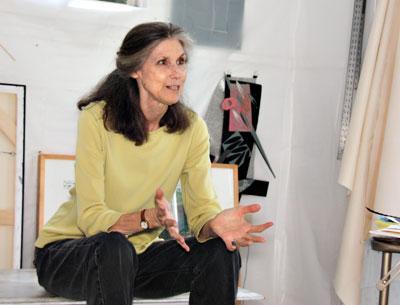Anne Seelbach Sees Sea Life

To hear Anne Seelbach talk about the painting, stencils, and bas-relief collages she’s been doing recently — “to bring awareness of the effects of industrial and chemical pollution on the marine environment” — one might easily conclude that she has become political, but it is not the case. “I am first an artist, not an activist,” she said at her Sag Harbor studio, adding, however, that “it is also true that I hope to bring awareness to nature as I see it.”
Ms. Seelbach is interested in the innate response of the natural world to the rotation of the earth around the sun and the resulting change of seasons — for example, the yearly mating of horseshoe crabs during the summer solstice, or the green shoots arising from the cold earth toward the end of winter — and in the artificial contaminants and chemicals that are having such a destructive effect on our environment. She has moved from representational depictions of sea life to more abstract ones, such as paintings in which plastic mesh debris looks like scales on the fish.
She has been peripatetic from adolescence, when her family moved from Michigan to Bronxville. She remembered visiting her grandparents every summer as a young child at Portage Lake in Michigan, which may be why, when invited to visit a neighbor’s house in Sag Harbor, she found the East End so familiar. She fell in love with the water and the village. “It was so simple here then, cosmopolitan but not pretentious.”
Bringing out a painting from the early 1950s of a beach scene, Ms. Seelbach said she has been making art all her life, starting when her best friend was given a set of oil paints and she was hooked by “the colors and the smell.” Her mother found a Saturday class for her, as her Michigan public school had no real art instruction, and she went on to earn a B.A. at New York University and an M.F.A. from Hunter College, followed by a painting fellowship at Radcliffe’s Bunting Institute.
When she found her house and the studio she now uses, her landlord, a contractor, covered its cement floor with plywood and two layers of insulation underneath, making it possible to use in the winter.
A while back, Ms. Seelbach went to the dock on Noyac Road, lay down, looked at the water, and saw a fish that looked “like a pencil, with an eye in the middle of its body.” She’d been reading about mutations in nature resulting from pollution, and her interest was sparked.
As time went on, she said, such variants seemed to be moving closer and closer to home, and her paintings changed to reflect it, becoming more abstract. Then she found herself wondering if she could make the works more accessible to the viewer — “less squished in by the mat, the glass, and the frame.”
She was painting on paper and canvas, throwing the paper on the floor and painting the pieces, then reassembling them in a collage. The process made the work more accessible but also more fragile, a tradeoff that, she said, she is willing to make.
For now, Ms. Seelbach will continue exploring and experimenting with low bas-relief and subject matter connected to sea life. She has exhibited a lot this year, for which she is grateful, even though “there is so much involved in the business end that I’m thrown out of my routine.”
The solution? “Now it’s time to shut that curtain and come in here and putter about.”
